Gold, glass, and marble dazzle the eye in this 6th-century church. High above us, Emperor Justinian presides.
San Vitale, begun c. 526–27, consecrated 547, Ravenna (Italy). Speakers: Dr. Beth Harris and Dr. Steven Zucker
[0:00] [music]
Dr. Steven Zucker: [0:04] We’re in the Italian city of Ravenna, standing outside of the Church of San Vitale. This is a really important 6th-century church.
Dr. Beth Harris: [0:12] It’s unusual in that it’s a centrally planned church.
Dr. Zucker: [0:17] When we think about a church, we generally think about a building that’s shaped like a cross, and it has that long hallway, the nave. This doesn’t have that. Instead, it’s got an ambulatory, or an aisle, that surrounds the central space. In this particular case, on the east side of the church, there’s also an extension with an apse at the end.
Dr. Harris: [0:34] We see that it has eight sides, so it’s an octagon. Within that octagon is a smaller octagon that rises higher.
Dr. Zucker: [0:42] The walls are pierced with lots of windows, and that’s especially important because the interior is covered with some of the most magnificent mosaics from the early medieval period.
Dr. Harris: [0:51] Let’s go inside and have a look.
Dr. Zucker: [0:52] We’ve walked into the church, and the center towers over us. There are massive piers that help support the building, but there’s also a real delicacy. Look, for instance, at the way that the columns are doubled, that is, stacking of one set of columns above the next.
Dr. Harris: [1:07] They move in and out, back into the space of the ambulatory on the ground floor and then up into the gallery above.
Dr. Zucker: [1:14] The eastern end of San Vitale is completely covered in dense mosaic, and they might at first seem disconnected, but in fact, there is a unifying theme.
Dr. Harris: [1:24] Art historians have talked about the theme of offering, of sacrifice. We see that in the scenes of Abel and Melchizedek, who make an offering to God. We see God’s hand above accepting that offering.
Dr. Zucker: [1:39] In the opposite lunette we see Abraham sacrificing Isaac, or almost sacrificing Isaac.
Dr. Harris: [1:46] On the other side of the lunette, Abraham offers bread [to] three strangers who come to his door, who are understood as God. All of this relates to the offering made by the priest at the altar of the Eucharist, the bread and wine that are the body and blood of Christ. The idea of God’s sacrifice so that mankind can be redeemed and can have eternal life in heaven.
[2:12] Much of the mosaic is about what eternal life in heaven is like.
Dr. Zucker: [2:16] These glittering gold tesserae must have felt miraculous. You can so clearly see the uneven surfaces in the way that they pick up light.
Dr. Harris: [2:26] Most of the tesserae are colored glass or gold sandwiched between glass, but we also have silver and mother of pearl.
Dr. Zucker: [2:34] And in some areas, stone that is less reflective and creates a dynamic contrast with the glistening quality of the metallic and glass tesserae. And if you look really closely, you start to get a sense of the art of mosaicists. They had to up-close represent what would resolve into an image at a distance.
Dr. Harris: [2:54] We can see that at times the mosaicist uses bright orange tesserae to make highlights, and from far away, you don’t see that bright orange. It resolves in our eye to form faces that appear quite naturalistic.
Dr. Zucker: [3:11] This is truly painting with stone.
Dr. Harris: [3:13] The individual tesserae curve around a face, for example, or around a halo. Everywhere we look, we see life, and that speaks to the idea of the afterlife. We see so many different kinds of birds, and flowers, and animals, and vines, and fruits, and cornucopia.
[3:34] We see unexpected forms. For example, we see dolphins with their tails entwined in one another. Though art historians often disagree about the specific meaning of the dolphins and the shells, they clearly referred to Christ, to the apostles who they surround.
Dr. Zucker: [3:52] There are so many things to see, and just in terms of the natural world, if we look all the way up at the top, I love the three doves that surround these urns joined by this amazing arcing vine.
Dr. Harris: [4:03] The vine yields fruit. It yields grapes, which refer to the wine of the Eucharist, the blood of Christ. We see birds wading in the water and in the water we see reeds and rocks. We also see apples, and pears, and other kinds of fruit.
Dr. Zucker: [4:22] Flowers are everywhere. This really is paradise. There are three large windows, and just above that, a large apse mosaic.
Dr. Harris: [4:30] In the center we see Christ dressed royally in purple, sitting on an orb, the orb of the earth, of the universe. Below flow the four rivers of paradise, and on either side of him, an angel.
Dr. Zucker: [4:43] Christ is holding the book of the Apocalypse, with the seven seals visible. In his right hand, he’s handing a crown to San Vitalis, who was adopted as the primary martyr of this city.
Dr. Harris: [4:55] On the other side we see Ecclesias, who founded and sponsored the building of this church, and we see him handing the church to the angel beside Christ. Every surface was covered with imagery, with figures, with decorative patterning.
[5:11] Right above the altar, we see an image of the Lamb of God, and the Lamb of God refers to Christ. He’s wearing a halo. This idea of Christ as the sacrificial lamb, sacrificed for the redemption of mankind.
Dr. Zucker: [5:26] The lamb is surrounded by a wreath of victory. In this case, the idea of the triumph of Christianity itself. That wreath is held in place by four angels who stand on globes that refer to the globe upon which Christ in the apse sits.
Dr. Harris: [5:41] We see Christ again, but this time, bearded, older, in the archway.
Dr. Zucker: [5:46] The triumphal arch has Christ in the center, and his body is surrounded by a mandorla, a kind of rainbow-colored halo. Moving down the arch on either side are 14 figures, including the apostles. There are also fabulously decorative columns made out of a high-quality marble that was brought from the East.
[6:04] What’s most remarkable about these columns is that we’ve really left behind the classical orders. These are not Doric, they’re not Ionic, they’re not Corinthian. They are early Christians trying to invent a new iconography for their architecture.
Dr. Harris: [6:19] On top of the capitals, we see impost blocks that help make the transition up to the arches.
Dr. Zucker: [6:24] The two most important mosaics in San Vitale flank the apse.
Dr. Harris: [6:28] Those show the Emperor Justinian and his empress, Theodora. Now, Justinian and Theodora never came to Ravenna.
Dr. Zucker: [6:37] They’re in the mosaics, we think, to reassert their control over the city.
Dr. Harris: [6:41] For much of the 400s, Ravenna was under the control of a Goth, Theodoric. Theodoric was an Arian. That is, he didn’t follow the orthodox doctrines of the church. Justinian, the emperor in Constantinople, sends his general to re-conquer Ravenna and re-establish Orthodox Christian belief.
Dr. Zucker: [7:05] What we’re seeing here is the reassertion of Eastern imperial control, that is, Justinian is in Constantinople and he is saying, “I’m in charge. Even here in Ravenna, in Italy.” We see Justinian in the center, wearing purple, the color that is associated with the throne, and he’s surrounded by his court, but there are also religious figures representing the church, and there are soldiers.
[7:28] Three centers of power — the church, the emperor, and the military.
Dr. Harris: [7:32] We can see that some of the figures are treated more individualistically than others. Justinian, Maximian are more individualized but the figures from the army are much more anonymous.
Dr. Zucker: [7:42] Justinian, the emperor, his authority is divine. You can see a halo around his head, and he holds a bowl associated with [the] Eucharist, which [he] is handing in the direction of Christ in the apse.
Dr. Harris: [7:53] This is a bowl that would’ve contained the bread for the sacrament of the Eucharist. He’s in the center of the composition. He’s frontal, but really all of the figures are frontal.
Dr. Zucker: [8:03] They are schematic, abstracted. This is the medieval. We’ve left the classical tradition of naturalism behind.
Dr. Harris: [8:10] If we look closely at the figures, we can see that there’s no real concern for accurate proportions. Their feet don’t really seem to carry the weight of their bodies. They seem to float in a eternal space and not in an earthly space. Next to Justinian, we see the bishop, Maximian, his name above him — although that was added later — and beside him other clergymen.
Dr. Zucker: [8:34] Maximian holds a beautiful jeweled cross.
Dr. Harris: [8:37] The figures next to him hold a jeweled book of the Gospels, and the figure at the far right holds an incense burner.
Dr. Zucker: [8:44] To the right of the apse windows we see the panel of Theodora, the empress, and it mirrors the panel with Justinian.
Dr. Harris: [8:51] We have an idea that Theodora ruled as co-equal to Justinian.
Dr. Zucker: [8:56] She’s wearing incredibly elaborate clothing and jewelry with rubies, with emeralds, with sapphires, and very large pearls. In back of her head, just like Justinian, is a halo.
Dr. Harris: [9:08] Like Justinian, who’s carrying a bowl that held the bread for the Eucharist, Theodora is carrying the chalice for the wine for the Eucharist, and she’s surrounded by attendants that symbolize the imperial court. A curtain is raised as though she is about to take part in a ceremony.
Dr. Zucker: [9:26] I’m really taken by the elaborate Byzantine costume.
Dr. Harris: [9:30] Well, there’s a sense of trying to bring the richness of the imperial court in Constantinople here to Ravenna.
Dr. Zucker: [9:37] There is an expression of hierarchy. We know even from the feet who the emperor is, look at those incredible shoes. But as extraordinary, as brilliant as the mosaic is, it’s not the only showpiece in this church.
[9:52] For the medieval viewer, the dynamic abstractions that we see in the stone revetment, or stone panels, have been opened up so as to produce these extraordinary patterns. This tradition of elaborate stone revetment goes back to imperial Rome, and even before that to Hellenistic Greece. It was rooted in this great ancient tradition.
Dr. Harris: [10:16] So much of what we see here comes from that pagan tradition. This idea of the abundance of life in the waters comes from images of the Nile River.
Dr. Zucker: [10:26] Mosaic itself was a Roman art that the Romans used primarily on their floors.
Dr. Harris: [10:33] We have the mosaics, these panels of marble that have been cut open. We have these beautiful monolithic marble columns. We also have carved marble in the capitals where we see vines and tendrils. That idea of growing, of abundance.
[10:50] We also see in the impost blocks lambs on either side of a cross. The idea of Christ as the Lamb of God. The Lamb which is sacrificed for the redemption of mankind.
Dr. Zucker: [11:02] The individual elements in the mosaic are so dynamic. The vines are curling, the animals are moving, people are enacting. The same is true for the architectural space. The patterns in the revetment seem as if they’re alive. And then the very architecture has a series of apse bays that rise up to the dome.
[11:22] This entire space is dynamic. It is this lush, glorious space here in this city that’s distant from the capital of the empire, but that speaks to its importance.
[11:32] [music]
San Vitale is one of the most important surviving examples of Eastern Roman “Byzantine” Empire architecture and mosaic work. It was begun in 526 or 527 under Ostrogothic rule. It was consecrated in 547 and completed soon after.
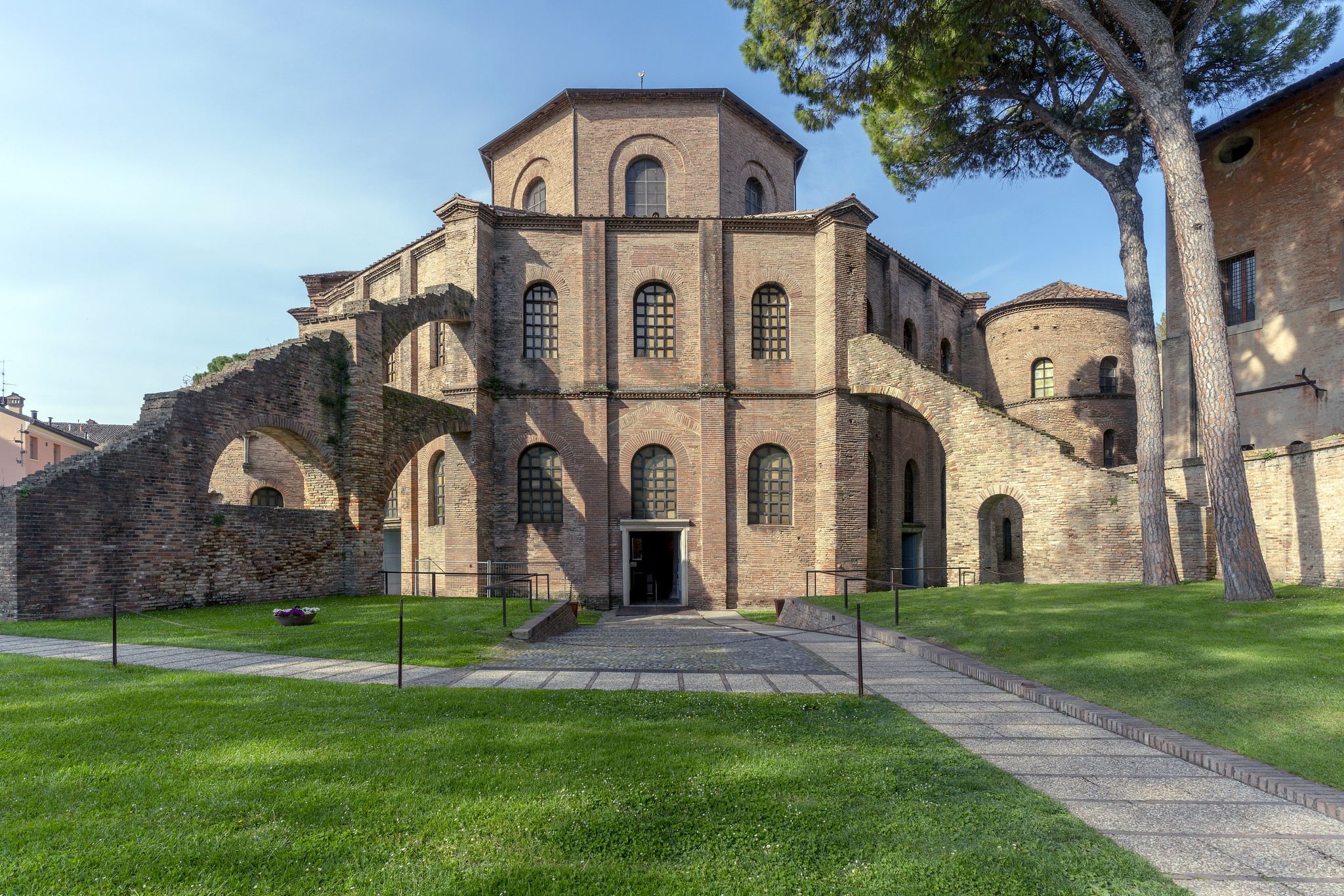
San Vitale, begun c. late 520s, consecrated 547, mosaics date between 546 and 556. The Church was restored 1540s, 1900, 1904, and in the 1930s, Ravenna, Italy (photo: Steven Zucker, CC BY-NC-SA 2.0)
One of the most famous images of political authority from the “middle ages“ is the mosaic of the Emperor Justinian and his court in the sanctuary of the church of San Vitale in Ravenna, Italy. This image is an integral part of a much larger mosaic program in the chancel (the space around the altar).
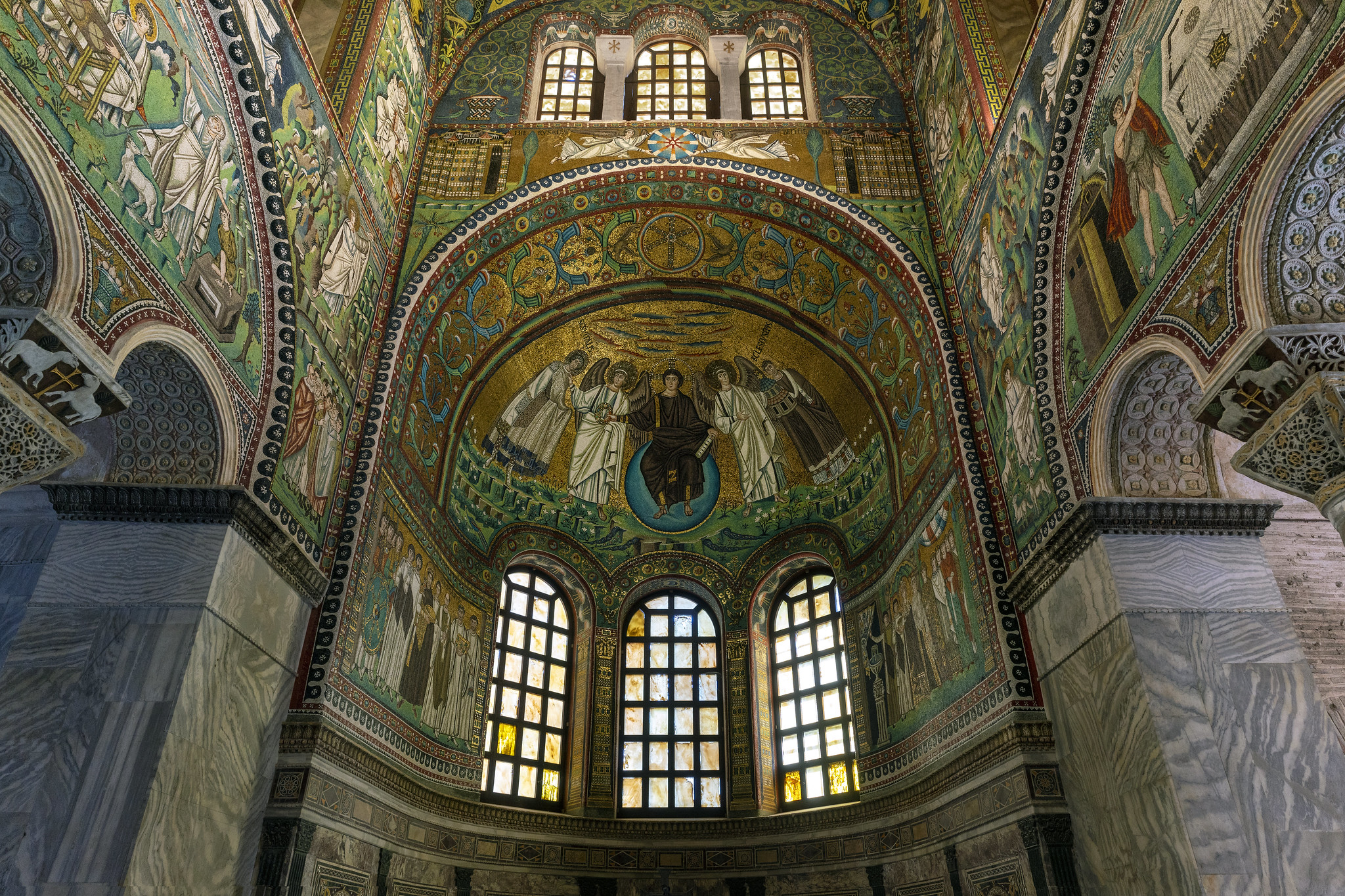
Chancel with Justinian mosaic at lower left and apse mosaic at center, San Vitale, consecrated 547, Ravenna, Italy (photo: Steven Zucker, CC BY-NC-SA 2.0)
A major theme of this mosaic program is the authority of the emperor in the Christian plan of history.
The mosaic program can also be seen to give visual testament to the two major ambitions of Justinian’s reign: as heir to the tradition of Roman Emperors, Justinian sought to restore the territorial boundaries of the Empire. As the Christian Emperor, he saw himself as the defender of the faith. As such it was his duty to establish religious uniformity or Orthodoxy throughout the Empire.
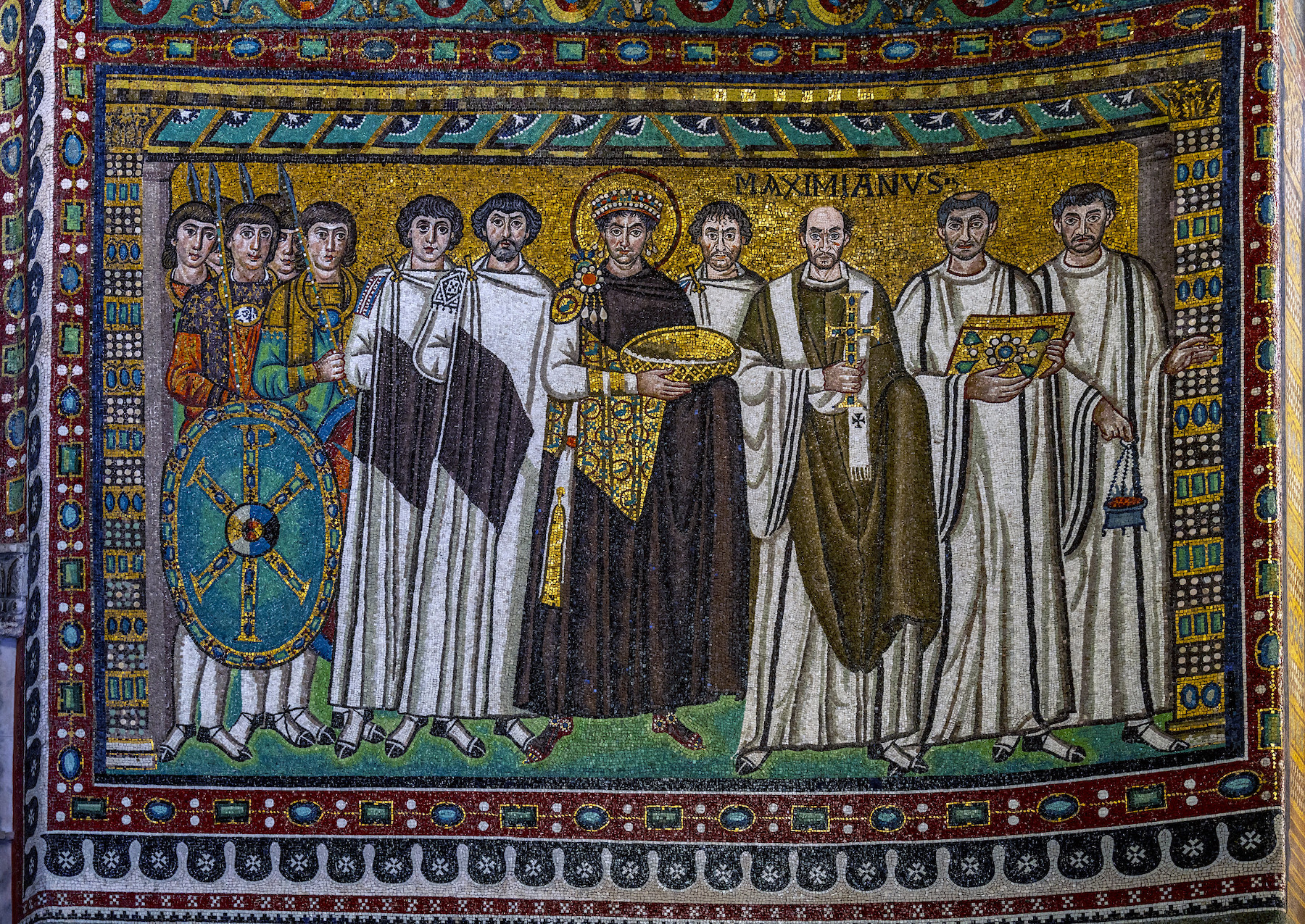
Justinian mosaic, San Vitale, consecrated 547, Ravenna, Italy (photo: Steven Zucker, CC BY-NC-SA 2.0)
Who’s who in the mosaic and what they carry
In the chancel mosaic Justinian is posed frontally in the center. He is haloed and wears a crown and a purple imperial robe. He is flanked by members of the clergy on his left with the most prominent figure the Bishop Maximianus of Ravenna being labelled with an inscription. To Justinian’s right appear members of the imperial administration identified by the purple stripe, and at the very far left side of the mosaic appears a group of soldiers.
This mosaic thus establishes the central position of the Emperor between the power of the church and the power of the imperial administration and military. Like the Roman Emperors of the past, Justinian has religious, administrative, and military authority.
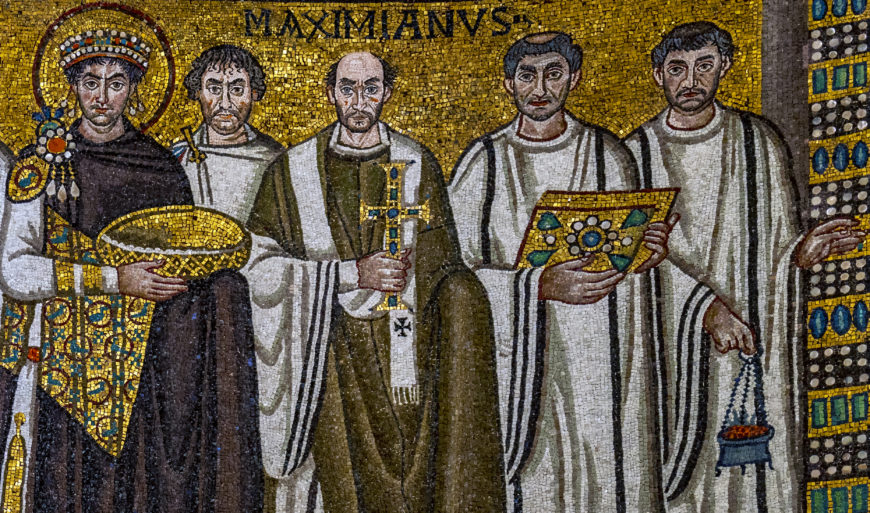
Clergy and Justinian (detail), Justinian mosaic, San Vitale, consecrated 547, Ravenna, Italy (photo: Steven Zucker, CC BY-NC-SA 2.0)
The clergy and Justinian carry in sequence from right to left a censer, the gospel book, the cross, and the bowl for the bread of the Eucharist. This identifies the mosaic as the so-called Little Entrance which marks the beginning of the Byzantine liturgy of the Eucharist. Justinian’s gesture of carrying the bowl with the bread of the Eucharist can be seen as an act of homage to the True King who appears in the adjacent apse mosaic.
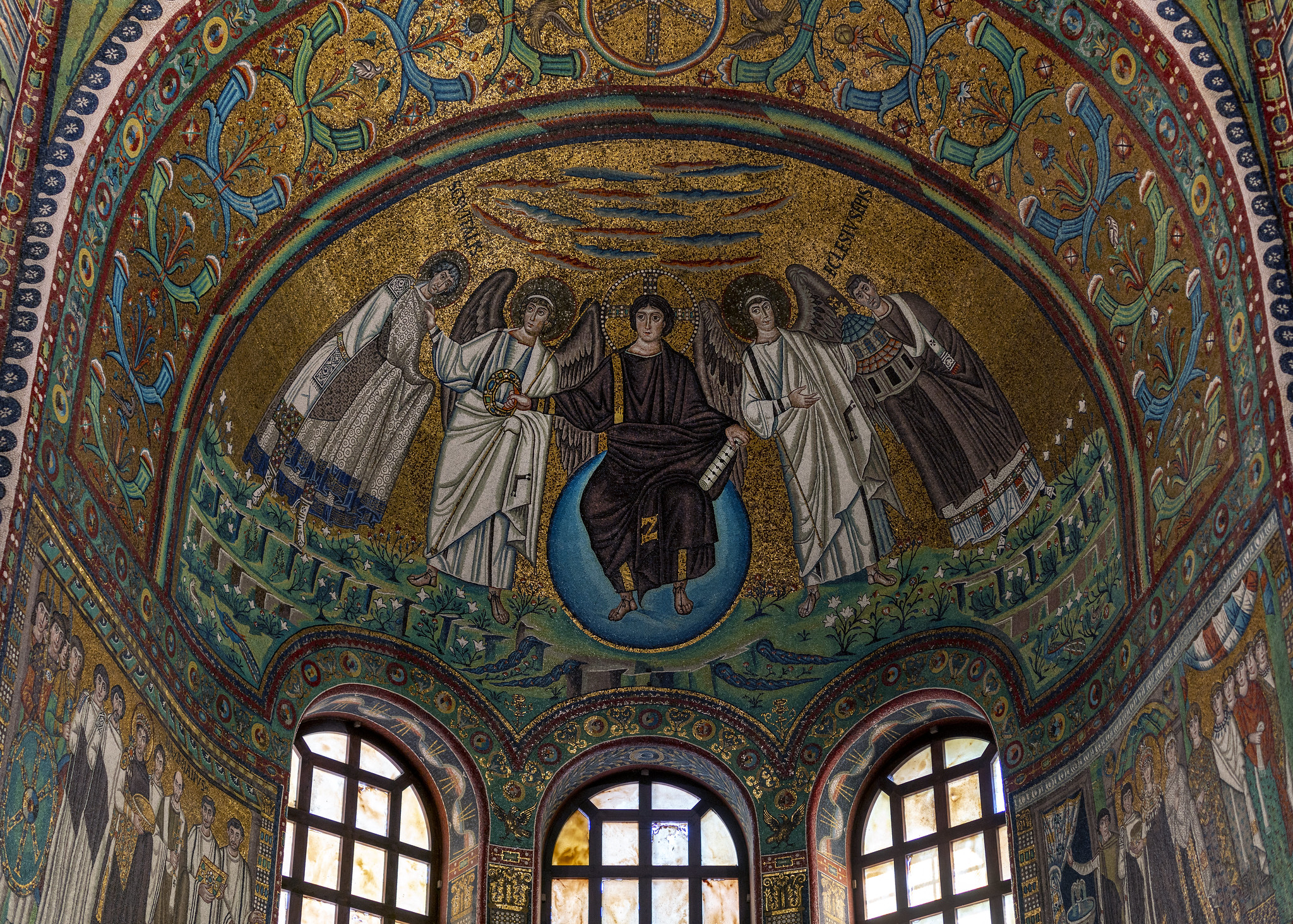
Apse with Jesus Christ and St. Vitale at center, Justinian mosaic below at lower left, San Vitale, consecrated 547, Ravenna, Italy (photo: Steven Zucker, CC BY-NC-SA 2.0)
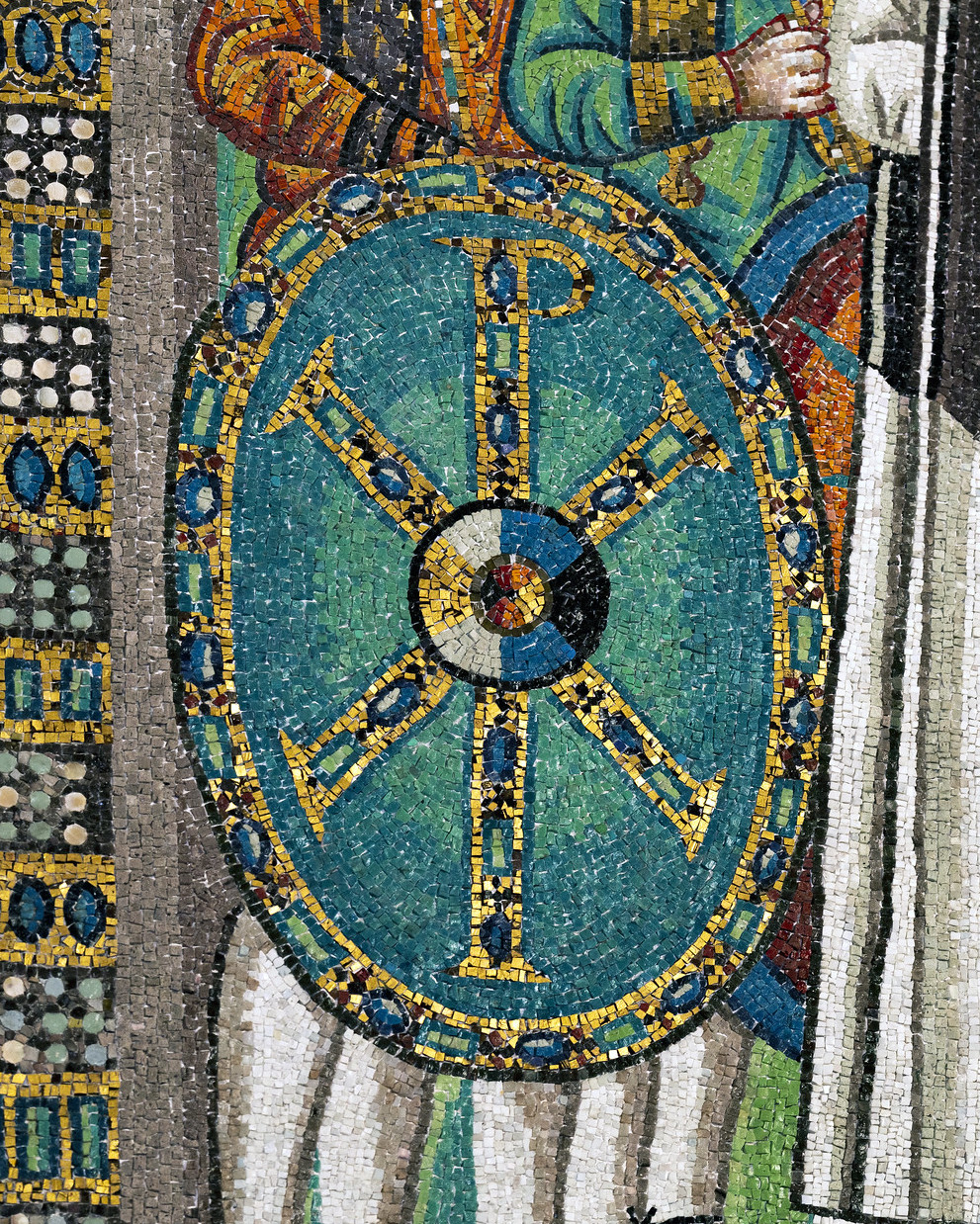
Chi-Rho on shield (detail), Justinian mosaic, San Vitale, consecrated 547, Ravenna, Italy (photo: Steven Zucker, CC BY-NC-SA 2.0)
Christ, dressed in imperial purple and seated on an orb signifying universal dominion, offers the crown of martyrdom to St. Vitale, but the same gesture can be seen as offering the crown to Justinian in the mosaic below. Justinian is thus Christ’s vice-regent on earth, and his army is actually the army of Christ as signified by the Chi-Rho on the shield.
Who’s in front?
Closer examination of the Justinian mosaic reveals an ambiguity in the positioning of the figures of Justinian and the Bishop Maximianus. Overlapping suggests that Justinian is the closest figure to the viewer, but when the positioning of the figures on the picture plane is considered, it is evident that Maximianus’s feet are lower on the picture plane which suggests that he is closer to the viewer. This can perhaps be seen as an indication of the tension between the authority of the Emperor and the church.
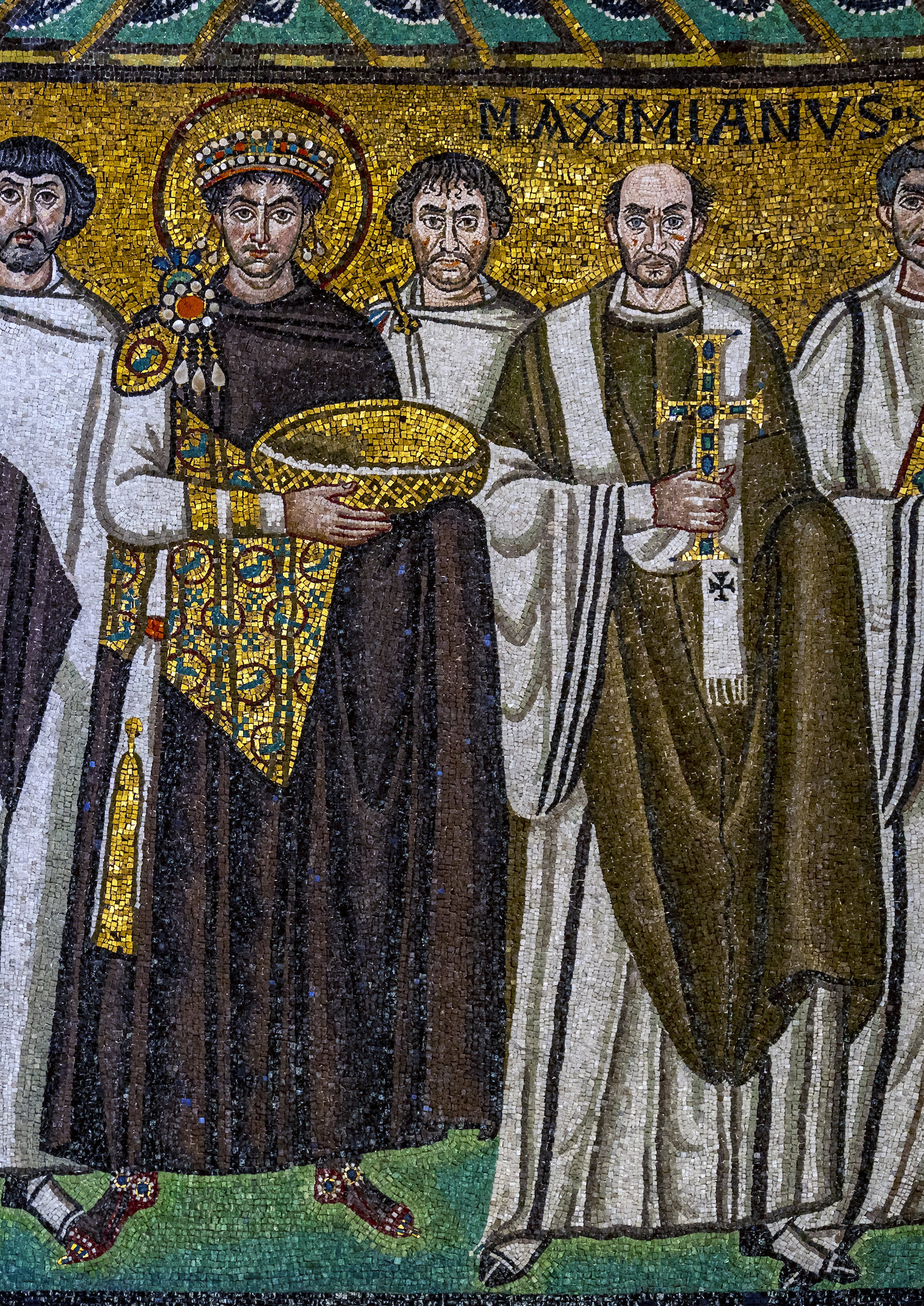
Justinian and Maximianus (detail), Justinian mosaic, San Vitale, consecrated 547, Ravenna, Italy (photo: Steven Zucker, CC BY-NC-SA 2.0)

